You'll need a T-ring mount that matches your specific camera's lens mount system (like Canon EF, Nikon F, or Sony E-mount) to connect with 2-inch telescope adapters. These T-rings typically use standard M42x0.75 (T2) or M48x0.75 (wide T-thread) specifications, which guarantee secure attachment to your telescope's focuser. For peak performance, choose an adapter made of durable aluminum with proper threading and a secure locking mechanism. Understanding your setup's specific requirements will reveal the full potential of your astrophotography gear.
Understanding 2-Inch Camera Mount Basics
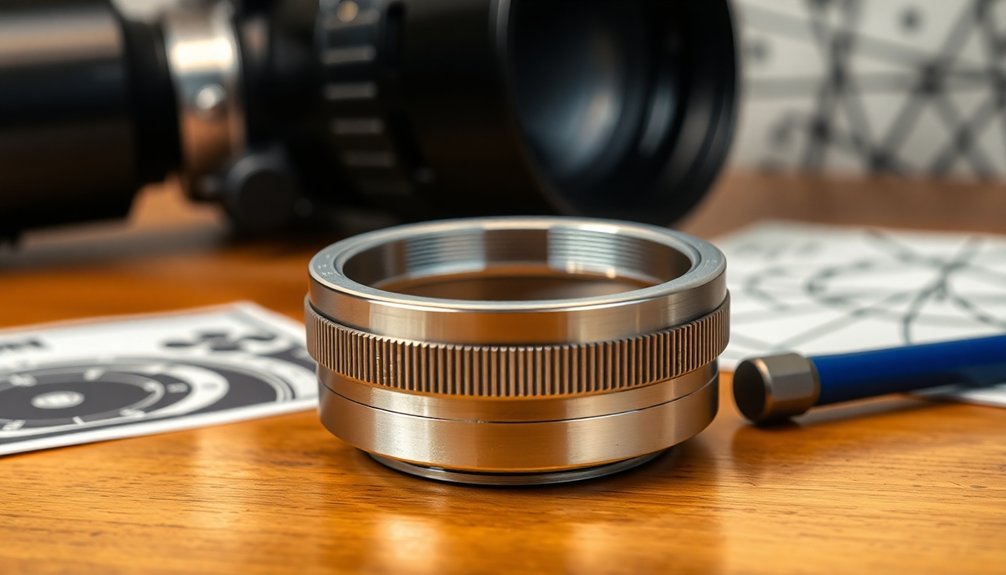
Camera adapters for telescopes come in two primary sizes: 1.25-inch and 2-inch formats.
When you're working with 2-inch adapters, you'll need a T-Ring mount that matches your specific camera's lens mount system, such as Canon EF or Nikon F.
You can fit a 1.25-inch adapter into a 2-inch focuser using an additional adapter, but if your telescope has a 2-inch focuser, it's often better to use a 2-inch adapter for wider field views and better light transmission. Each additional optical element in the adapter can cause a 3-4% light loss through the system.
The focuser's locking mechanism will secure your adapter firmly in place, preventing any unwanted movement during imaging sessions.
When selecting your adapter, you'll want to verify it's well-constructed to minimize light loss and maintain peak image quality through your optical train.
Types of Compatible T-Ring Systems
Modern T-ring systems accommodate a wide range of camera brands and mounting configurations.
You'll find specific T-rings designed for Canon EOS mounts, Nikon F and Z mounts, Sony Alpha and E-Mount cameras, Fujifilm X-Mount, and Pentax K-mount systems.
When selecting your T-ring, you'll need to take into account thread compatibility.
The most common option is the M42x0.75 (T2) thread, though some systems use larger M48x0.75 or M54x0.75 threads for enhanced compatibility.
T2 threads remain the standard at M42x0.75, while larger M48 and M54 threads offer expanded options for specialized mounting needs.
Baader Planetarium offers both T2 threads and their unique 52mm dovetail system.
For prime focus photography, specialized adapters like True-2 UltraWide systems connect directly to 2-inch barrels.
These are available for most major camera brands and offer quick switching between camera and eyepiece configurations without sacrificing optical performance.
Our team of telescope experts can help you select the perfect T-ring system for your specific setup and photography goals.
Essential Components for 2-Inch Mounting

Building on the various T-ring systems, you'll need specific components to create a reliable 2-inch mounting setup. The foundation starts with durable aluminum adapters that feature black anodized coating for protection and longevity.
You'll want to guarantee your adapter's threads match your telescope's focuser specifications. Your camera's T-ring must lock securely to your specific camera mount, whether it's Nikon F, Canon EOS, or another brand. When installing, listen for the distinctive "click" that confirms proper attachment. The 2-inch T adapter provides superior performance compared to 1.25-inch versions.
The adapter needs to fit snugly into your telescope's 2-inch focuser, secured by locking screws to prevent any movement. Depending on your setup, you might need extension tubes for proper focus.
Don't forget essential accessories like remote shutter releases to minimize vibration during imaging.
Measuring Your Telescope's Focuser
You'll need to measure your telescope's focuser carefully to guarantee proper camera mounting compatibility with 2-inch adapters.
Start by checking the inside diameter of your focuser using precision calipers, being mindful of D-shaped shafts that require special measurement attention.
Your focuser's measurements will determine the correct coupling size needed, so take multiple readings to confirm accuracy.
Remove any dual speed knobs before taking measurements to ensure proper clearance for installation.
Standard Focuser Design Specs
Accurate telescope focuser measurements are essential for selecting the right camera mount adapters and accessories.
When evaluating your focuser, you'll need to know that standard sizes come in either 1.25-inch or 2-inch diameters, which determine what eyepieces and adapters you can use.
Your focuser's base plate diameter matters too, with common sizes ranging from 86.4mm to 112.5mm to match different telescope tubes.
The focuser's construction material – whether plastic, aluminum, or steel – affects both its durability and precision. Many high-quality focusers are made with CNC machined aluminum for optimal performance.
You'll want to check the weight capacity, ensuring it can support your camera equipment up to 6 pounds.
For precise measurements, look for laser-etched scales on the drawtube, and consider the focuser's travel distance, which typically ranges from 15mm to 79mm.
Inside Diameter Check Method
Now that you understand standard focuser specifications, measuring your telescope's inside diameter is the next vital step for selecting the right accessories.
You'll need calipers for precise measurement and a clean workspace.
For bracket-style focusers, remove the coarse focus knobs and measure the protruding shaft.
If you have a clamp-style focuser, you'll need to remove the dual-speed knobs by loosening their set screws.
When measuring, avoid the flat surfaces on D-shaped shafts to guarantee accuracy.
Most focusers come in standard sizes of 0.965", 1.25", or 2". Measuring the inner diameter only will give you the critical information needed for eyepiece compatibility.
Getting an accurate measurement is essential because it determines which adapters and eyepieces you can use.
Remember to check your telescope's manual for specific instructions, as focuser designs can vary between models.
Popular Brand Compatibility Guide
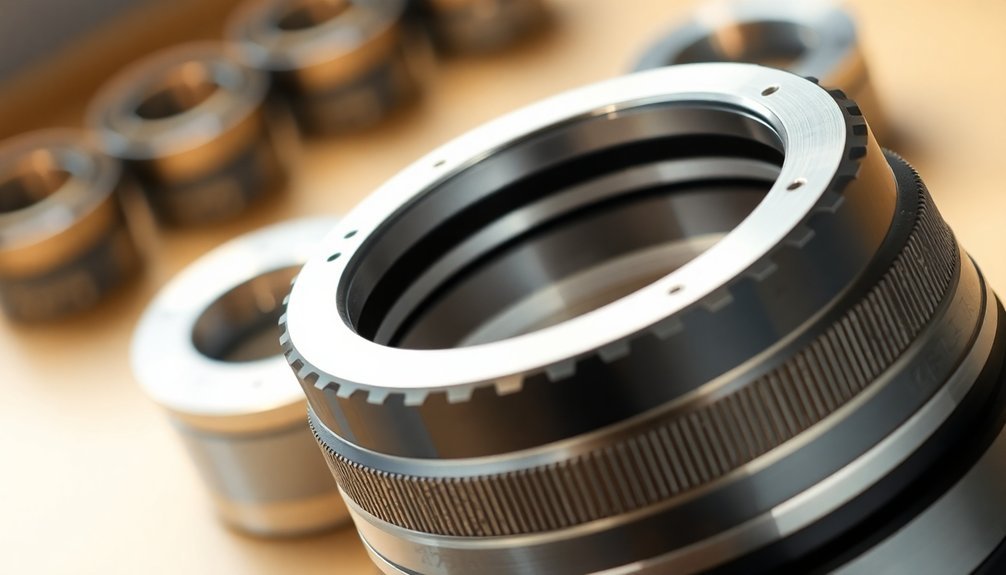
You'll find that major telescope manufacturers like Celestron, Meade, and Orion offer compatible 2-inch adapters for most popular DSLR camera brands, including Canon, Nikon, and Sony.
Your camera's specific mount type determines which T-ring you'll need – for instance, Canon EOS cameras require an EF-mount T-ring, while Nikon cameras need an F-mount version.
When selecting your adapter setup, check both the camera-side mount specifications and the telescope-side threading (typically M42x0.75 or M48x0.75) to guarantee proper compatibility. A prime focus adapter provides the most direct camera attachment method for optimal astrophotography results.
Major Brands and Adapters
Selecting compatible adapters for telescope cameras requires understanding the major brands and their specific mounting requirements.
You'll find that Apertura adapters work with 2-inch focusers and feature aluminum construction with black anodizing.
TelescopeAdapters Prime Focus models offer UltraWide clear apertures for enhanced astrophotography with Canon, Nikon, and Sony cameras.
You'll need to match your T-ring to your specific camera brand, as these aren't interchangeable.
While brands like ScopeStuff and First Light provide compatibility with Orion and Skywatcher telescopes, it's essential to recognize that Apertura adapters don't currently work with Orion 2-inch filters.
Most adapters feature standard M42x0.75 threads, though some newer models use M48x0.75 or M54x0.75 for broader compatibility options.
The True-2™ technology found in many modern adapters provides up to 10mm additional clear aperture compared to older legacy T-Ring designs.
Camera-Specific Mount Requirements
Three key components form the foundation of camera-to-telescope mounting: T-rings, adapters, and bayonet connections.
When selecting your mount, you'll need specific adapters based on your camera brand. T2 adapters with 42mm fine threads work across brands, while 2-inch prime focus adapters connect directly to camera bayonets for maximum light efficiency. Many astronomers prefer compression ring adapters for secure equipment attachment.
- Canon EOS cameras work with standard T-mounts and True-2 UltraWide adapters, supporting full-frame sensors without vignetting.
- Nikon F-mount DSLRs require specific T-rings, with additional options needed for Z-series mirrorless cameras.
- Sony Alpha and E-Mount systems need specialized adapters that provide extra back-focus length for accessories, while Pentax, Olympus, and Fuji cameras each demand their own unique mounting solutions for proper telescope connection.
Common Mounting Issues and Solutions
While mounting a camera to your telescope may seem straightforward, several common issues can impact image quality and tracking accuracy.
You'll need to watch for flexure problems, where parts of your setup bend or flex during imaging, and loose connections that cause unwanted vibration.
To address these issues, make certain you've properly secured all components, especially when using 2-inch adapters. The ideal mounting solution involves screw-on camera attachments directly to the focuser for maximum stability.
Proper component securement is essential for astrophotography success, particularly when working with 2-inch adapters in your imaging setup.
Don't rely on finder shoe mounts for guide scopes, as they're often not stable enough. Instead, use solid mounting rings and regularly check that all screws are tight.
You'll also want to manage your cables carefully to prevent tugging or entanglement during tracking.
If you notice periodic errors in your mount's tracking, use software correction tools to compensate for gear imperfections.
Filter Integration With 2-Inch Mounts

When mounting filters to your 2-inch adapter, you'll need to verify the threading standards match exactly to guarantee a secure connection without gaps.
You can protect against light path interference by checking that your filters sit flush within the adapter's housing and don't protrude into the optical train. Using high-quality metal adapter rings provides the most stable and reliable connection for telescope imaging.
Your chosen filter must also have compatible thread pitch and diameter specifications, as incompatible combinations like Apertura adapters with Orion filters won't work properly.
Filter Threading Standards
Since astronomy filters come in various configurations, understanding the threading standards for 2-inch adapters is essential for successful equipment integration.
You'll find that most 2-inch filters feature metal rings with specific threading patterns, though some come without threads for simpler installation. The standard male thread specification is 48 mm x 0.6 for 2-inch astronomy filters. While certain filters include MA48 x 0.6 threads for additional accessories, there's no universal standard for front threading.
- T-rings are brand-specific (Canon, Nikon) and connect your camera to telescope adapters
- Series VII threads won't work for mounting standard 2-inch filters directly
- Custom or third-party adapters are often needed for proper filter integration
When working with 2-inch astronomy filters, remember that their dimensions and functionality differ greatly from standard camera filters, making direct mounting on camera lenses challenging without proper adapters.
Preventing Light Path Interference
Proper light path management stands as a critical factor in achieving high-quality astrophotography results with 2-inch telescope adapters. You'll need to guarantee your adapter setup minimizes any potential interference with the light reaching your camera's sensor.
Prime focus adapters are your best choice for optimizing light collection, as they reduce the distance between your camera sensor and telescope. When selecting an adapter, look for models like the UltraWide that offer greater clear aperture to prevent vignetting.
You can further enhance your setup by incorporating 2-inch filters into your adapter system, which helps manage light interference while improving contrast in your images. For Canon T1i DSLR users, step-down rings provide an effective solution for mounting 2-inch filters to smaller lens thread sizes.
If you're struggling to achieve proper focus, you can add extension tubes without compromising the light path. Just guarantee all components maintain seamless optical alignment.
Budget-Friendly Mount Options
Finding an affordable telescope mount doesn't mean you'll have to sacrifice quality. Several budget-friendly options can meet your astrophotography needs while keeping costs manageable.
The Skywatcher Star Adventurer and iOptron SmartEQ Pro+ offer excellent portability and tracking performance for beginners, while modified second-hand mounts like the EQ3/5 can provide substantial value. With proper maintenance, you can achieve 1.4 arcsecond accuracy with these mounts.
- Skywatcher AZ GTI: You'll get GOTO functionality and great portability, though you'll need modifications for equatorial mode.
- iOptron SmartEQ Pro+: This mount delivers reliable tracking and GoTo features at a reasonable price point.
- Second-hand EQ3/5: When modified by experts like Dave Woods, these mounts can match the performance of pricier alternatives.
While budget mounts may have lower payload capacities and tracking accuracy, they're perfect for learning astrophotography basics.
Advanced Features for Astrophotography

When pursuing deep-sky astrophotography, you'll discover several advanced features that can dramatically improve your imaging results. Your setup can benefit from focal reducers for wider fields of view and field flatteners to correct image curvature, especially with larger sensors. T-rings and adapters are essential components that allow secure mounting of DSLR and mirrorless cameras to telescopes.
Feature | Benefits | Applications
–|–|–
Focal Reducers | Wider field of view | Deep-sky objects
Field Flatteners | Edge star correction | Full-frame sensors
T-Adapter Variations | Specialized connections | RASA/EdgeHD scopes
Modern mounts now offer excellent payload capacity and advanced tracking features. You'll find that equatorial mounts with GoTo systems provide the precise tracking needed for long-exposure imaging. When using 2-inch adapters, you'll have access to a broader range of accessories and can easily integrate these advanced features into your imaging setup.
Maintaining Your Camera Mount Ring
Regular maintenance of your camera mount ring guarantees reliable performance and extends its lifespan during astrophotography sessions.
Proper care of your camera mount ring is essential for consistent results and longevity in astrophotography equipment performance.
You'll need to inspect for stuck adapters, clean surfaces with appropriate materials, and protect against corrosion in humid conditions. Using compressed air and soft cloths with specialized cleaning solutions helps preserve optical clarity while preventing scratches.
- Store your mount ring in a protective case when not in use, and keep it organized with proper labeling to prevent confusion with other accessories.
- Check regularly for signs of wear, rust, or material degradation, applying suitable lubricants to reduce friction between moving parts.
- If you encounter a stuck adapter ring, don't force it – try thermal expansion techniques or consult a professional to avoid damaging your equipment.
Selecting the Right Thread Size
Selecting the right thread size for your camera mount ring is essential for achieving a secure connection between your camera and telescope.
You'll commonly encounter M42x0.75 (T-thread) and M48x0.75 (wide T-thread) sizes, with the latter being ideal for 2-inch adapters to minimize vignetting.
If you're using a Schmidt-Cassegrain telescope, you'll need a 2"-24 SCT thread adapter.
For Maksutov telescopes, you might encounter the less common M44.5×1.0 thread, which often requires conversion.
When choosing your thread size, verify it matches both your camera's T-ring specifications and your telescope's connection point.
Consider using Baader's 52mm dovetailed adapters as an alternative to traditional threaded connections if you're working exclusively with Baader accessories.
Performance Factors to Consider
Understanding performance factors helps guarantee your camera mount ring delivers ideal results for astrophotography.
Getting the best astrophotography results starts with selecting a camera mount ring that meets key performance requirements.
When evaluating mount rings for 2-inch adapters, you'll need to take into account load capacity, mechanical reliability, and alignment precision. Your mount ring must securely support your equipment while maintaining perfect alignment during long exposure shots.
- Check the ring's load capacity to make sure it can handle your camera, accessories, and telescope setup without flexing or stress.
- Look for durable materials like machined aluminum that won't degrade from regular outdoor use and temperature changes.
- Verify the ring provides precise alignment features to maintain proper optical centering and prevent vignetting.
The mount ring's performance directly impacts image quality, so don't compromise on these critical factors when making your selection.
Tips for Secure Camera Attachment
When attaching your camera to a telescope mount ring, proper security measures will protect your valuable equipment and guarantee ideal image quality.
Start by confirming your camera's T-Ring matches your specific mount type – whether you're using Canon EOS, Nikon F, or Sony Alpha systems. You'll need to verify the adapter is compatible with your telescope's 2-inch focuser.
To prevent camera shake, lock your focuser drawtube securely and consider adding counterweights for heavier setups.
You'll get the best results using prime focus technology, which eliminates unnecessary optical elements.
Don't forget to level your telescope and use a remote shutter release to minimize vibration during exposure.
Regular maintenance of your equipment, including checking adapter conditions and keeping optics clean, will assure consistent performance and sharp images.
Frequently Asked Questions
Can Camera Mount Rings Corrode When Used in High-Humidity Environments?
Yes, your camera mount rings can corrode in high humidity. Even with protective anodized finishes, you'll need to maintain them regularly and store them properly to prevent moisture damage to the metal components.
Do Temperature Changes Affect the Tightness of Telescope Camera Mount Rings?
Yes, you'll notice that temperature changes can affect your mount ring's tightness due to metal expansion and contraction. It's important to monitor and adjust the fit during significant temperature shifts while observing.
What's the Average Lifespan of a Camera Mount Ring's Threading?
You'll typically get 5-10 years from your camera mount ring's threading with proper care. If you're using it regularly and maintaining it well, the threads should remain reliable throughout this period.
Are Anodized Mount Rings More Resistant to Scratches Than Non-Anodized Ones?
Yes, you'll find anodized mount rings are considerably more scratch-resistant than non-anodized ones. The hard anodized coating creates a protective layer that's tougher than bare aluminum, making your equipment more durable.
How Often Should Camera Mount Rings Be Inspected for Wear?
You should inspect your camera mount rings monthly and after each observing session. Don't forget to check them before major astronomical events and after any transport or storage to prevent equipment damage.
In Summary
You'll find most standard T-rings with 42mm threads will work with 2-inch telescope adapters, provided you've got the correct nosepiece or step-down ring. Check your camera's specific mount type and verify you're using a T-ring that matches both your camera's bayonet mount and the telescope's 2-inch adapter specifications. Don't forget to test the secure fit before mounting your camera for astrophotography.
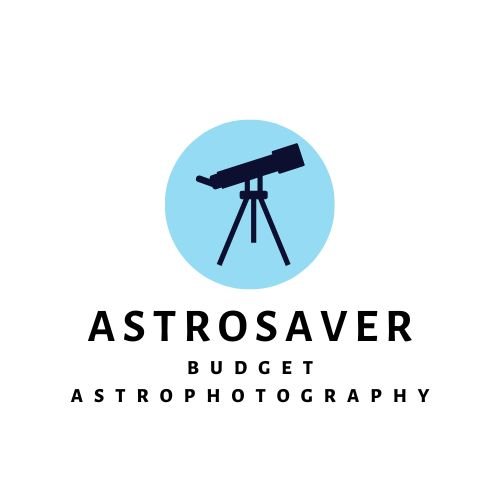

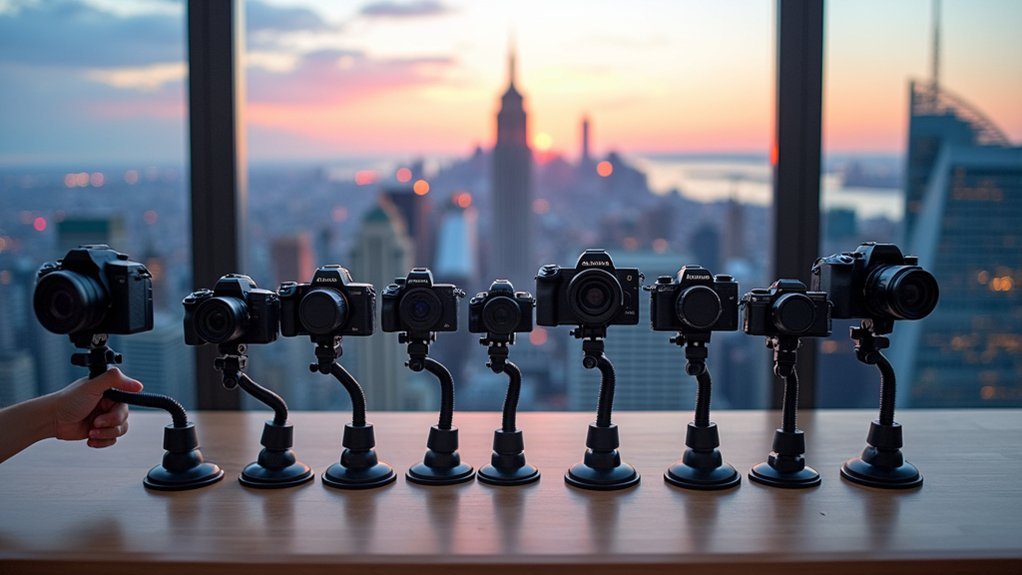

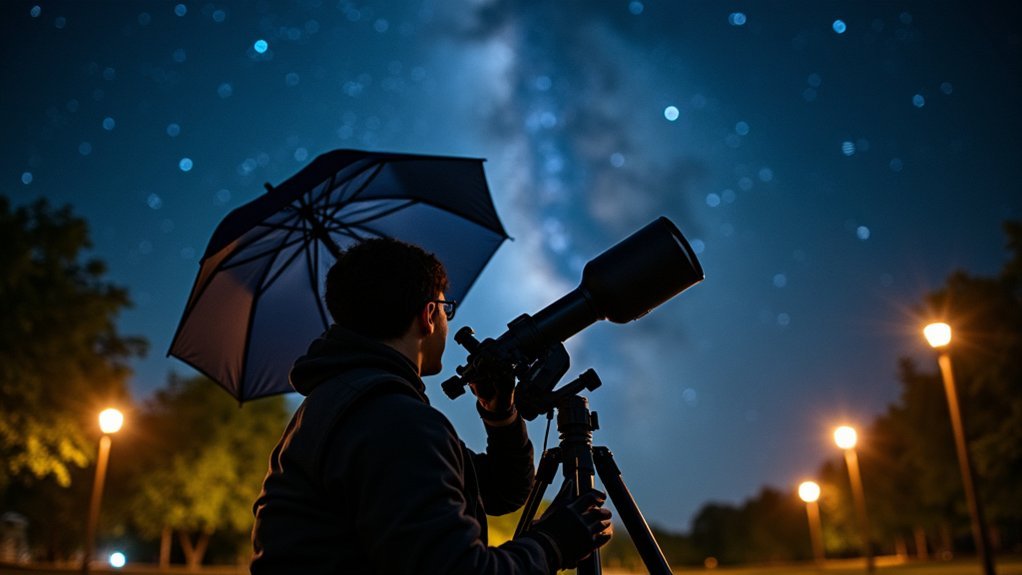
Leave a Reply